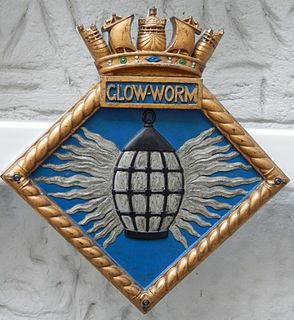Related Research Articles
Eight ships of the Royal Navy have been named HMS Ardent, whilst another two were planned:

Three ships of the Royal Navy have borne the name HMS Glowworm after the insect, whilst two more were planned:
Four Royal Navy ships have been named HMS Grenville. Vice Admiral Sir Richard Grenville was an Elizabethan sailor, explorer, and soldier:
Five ships of the Royal Navy have been named HMS Hampshire after the English county:
HMS Phoebe may refer to:
Seven ships of the Royal Navy have been named HMS Orpheus. Orpheus was the magical father of songs in Greek mythology.
Three ships of the Royal Navy have borne the name HMS Battleaxe:
Three ships of the Royal Navy have been named HMS Onslow:
Several ships of the British Royal Navy have been named HMS Partridge, after the bird.
Obdurate may refer to:
Seven ships of the Royal Navy have borne the name HMS Recruit:
Three vessels of the British Royal Navy have been named HMS Nerissa:
Two ships of the Royal Navy have been called HMS Sable after the small carnivorous mammal:
Three ships of the British Royal Navy have been named HMS Observer:
Three ships of the British Royal Navy have been named HMS Octavia:
Five ships of the Royal Navy have carried the name HMS Handy:
There have been two ships of the Royal Navy named HMS Rosalind, named after the protagonist in William Shakespeare's As You Like It:
Six vessels of the Royal Navy have been named HMS Ready:
At least three ships of the Royal Navy have borne the name HMS Sarpedon. They are named after Sarpedon, a Greek hero and son of Zeus.

HMS Obdurate was an Admiralty M-class destroyer which served with the Royal Navy during the First World War. The M class were an improvement on the previous L-class, capable of higher speed. Launched on 21 January 1916 by Scotts of Greenock, the vessel served as part of the Grand Fleet in the Battle of Jutland in May 1916. The destroyer formed part of the cover for the British battlecruisers and was involved in attacks on German battleships and destroyers, but recorded no hits. The destroyer was also part of attack by Zeppelin L 43 on Sydney and the distant cover for the Second Battle of Heligoland Bight, but received only minor damage from the German airship. After the armistice, Obdurate was assigned to the Local Defence Force at Nore and sold to be broken up on 9 May 1921.
References
- Colledge, J. J.; Warlow, Ben (2006) [1969]. Ships of the Royal Navy: The Complete Record of all Fighting Ships of the Royal Navy (Rev. ed.). London: Chatham Publishing. ISBN 978-1-86176-281-8.